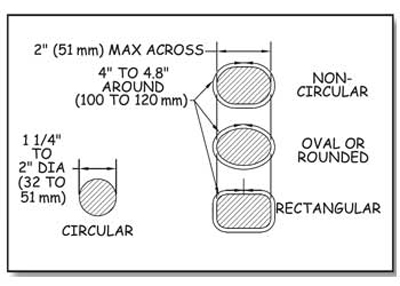Grab Bars
Grab bars are usually provided in buildings to provide stability and allow people to use their arms to assist in movement over short distances. The most common location for grab bars is in restrooms. Grab bars must comply with the reach range requirements of ABAAS, section 308, as explained in "Reach Ranges and Operability Requirements." They must also comply with the size, strength, finish, and position requirements in ABAAS, section 609 as follows:
-
Grab bars with circular cross sections must have a diameter no less than 1¼ inches (32 millimeters) and no more than 2 inches (51 millimeters). Grab bars with noncircular cross sections must not be more than 2 inches (51 millimeters) across and must be 4 to 4.8 inches (100 to 120 millimeters) around. Figure 56 shows how this is measured.
-
Grab bars and any wall or other surfaces adjacent to grab bars must have rounded edges and are not allowed to have sharp or abrasive surfaces.
-
Grab bars must be installed so they don't rotate within their fittings.
-
Grab bars have to be strong enough to support 250 pounds (1,112 newtons) of pressure at any point on the grab bar, fastener, mounting device, and supporting structure.
-
The space between the wall and the grab bar must be 1½ inches (38 millimeters). There must also be a space of 1½ inches (38 millimeters) between the grab bar and any projecting objects below or at the ends of the grab bar. There must be at least 12 inches (305 millimeters) between the grab bar and any projecting objects above it, except multiple grab bars only have to be 1½ inches (38 millimeters) apart.

Figure 56—The requirements for the diameter and circumference of grab bars.

User Comments/Questions
Add Comment/Question